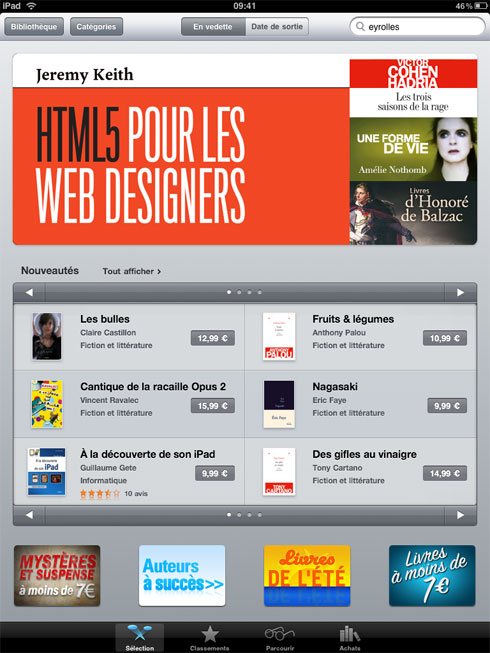MARISSA CHRISTINA joins Jeffrey Zeldman and Dan Benjamin to discuss her path as a web designer diagnosed with a debilitating vestibular disorder, and her blog Abledis.com, documenting living with a hidden disability.
Category: Advocacy
You are all in publishing!

ON SUNDAY, while leading a discussion on the future of web design and publishing, I noticed a slightly confused look appearing on some faces in the audience. The discussion had been billed as “Jeffrey Zeldman’s Awesome Internet Design Panel,” and I thought perhaps there was a disconnect for some in the audience between “design” and such topics as where content comes from and who pays for it.
So I asked, “Who here is in publishing?”
A few hands were gently raised.
Uh-huh. “And how many of you work on the web?”
Every right hand in the room shot up.
“You are all in publishing,” I explained.
Now, I like a good rounded corner talk as much as the next designer. I’ve given my share of them. Also of line height and measure, color and contrast, how to design things that don’t work in old versions of Internet Explorer, and so on. In the practice of web and interaction design, there will always be a place for craft discussions—for craft is execution, and ideas without execution are songs without music, meaningless.
But right now (and always) there is a need for design to also be about the big strategic issues. And right now, as much as design is wrestling with open vs. proprietary formats and the old challenges of new devices, design is also very much in the service of applications and publishing. Who gets content, who pays for it, how it is distributed (and how evenly), the balance between broadcast and conversation, editor and user—these are the issues of this moment, and it is designers even more than editors who will answer these riddles.

OUR LIBRARY IS BURNING. Copyright extension has banished millions of books to the scrapheap. Digital permanence is a tragically laughable ideal to anyone who remembers the VHS format wars or tries to view Joshua Davis’s 1990s masterpieces on a modern computer. Digital archiving is only as permanent as the next budget cycle—as when libraries switched from microfilm to digital subscriptions and then were forced to cancel the subscriptions during the pre-recession recession. And of course, my digital work vanishes the moment I die or lose the ability to keep hosting it. If you really want to protect your family photos, take them off Flickr and your hard drive, get them on paper, and store them in an airtight box.
Though bits are forever, our medium is mortal, as all but the most naive among us know. And we accept that some of what we hold digitally dear will perish before our eyes. But it irks most especially when people or companies with more money than judgement purchase a thriving online community only to trash it when they can’t figure out how to squeeze a buck out of it. Corporate black thumb is not new to our medium: MGM watered down the Marx Bros; the Saatchis sucked the creative life and half the billings out of the ad agencies they acquired during the 1980s and beyond. But outside the digital world, some corporate purchases and marriages have worked out (think: Disney/Pixar). And with the possible exception of Flickr (better now than the day Yahoo bought it), I can’t think of any online community or publication that has improved as a result of being purchased. Whereas we can all instantly call to mind dozens of wonderful web properties that died or crawled up their own asses as a direct result of new corporate ownership.
My colleague Mandy Brown has written a moving call to arms which, knowingly or unknowingly, invokes the LOCKSS method (“Lots of Copies Keep Stuff Safe”) of preserving digital content by making copies of it; she encourages us all to become archivists. Even a disorganized ground-level effort such as Mandy proposes will be beneficial—indeed, the less organized, the better. And this is certainly part of the answer. (It’s also what drives my friend Tantek’s own your data efforts; my beef with T is mainly aesthetic.) So, yes, we the people can do our part to help undo the harm uncaring companies cause to our e-ecosystem.
But there is another piece of this which no one is discussing and which I now address specifically to my colleagues who create great digital content and communities:
Stop selling your stuff to corporate jerks. It never works. They always wreck what you’ve spent years making.
Don’t go for the quick payoff. You can make money maintaining your content and serving your community. It won’t be a fat fistful of cash, but that’s okay. You can keep living, keep growing your community, and, over the years, you will earn enough to be safe and comfortable. Besides, most people who get a big payoff blow the money within two years (because it’s not real to them, and because there are always professionals ready to help the rich squander their money). By contrast, if you retain ownership of your community and keep plugging away, you’ll have financial stability and manageable success, and you’ll be able to turn the content over to your juniors when the time comes to retire.
Our library is burning. We didn’t start the fire but we sure don’t have to help fan the flames. You can’t sell out if you don’t sell. Owning your content starts with you.

IN NOVEMBER, as part of the 4th Annual Blue Beanie Day to support web standards, we announced a web standards haiku contest, with prizes donated by Peachpit/New Riders (“Voices That Matter”) and A Book Apart. Entries were posted on Twitter with the hashtag #bbd4, with judging to follow in December. It should have been easy.
Unfortunately, searches on hashtags only go back a few days. Which means, when Designing With Web Standards 3rd Edition co-author Ethan Marcotte and I sat down to judge your entries, said entries were nowhere to be found.
Not even mighty Google was able to uncover more than a few of them.
We wrote to our friends at Twitter to ask for help, but they were too busy dating supermodels on a pile of money to get back to us. With existing entries sucked into the void formerly known as Twitter search results, and with all those great books to give away and all those eager participants to thank, we have only one choice:
Blue Beanie Day Haiku Contest Phase II—This Time It’s Personal
Instructions follow:
Attention, web design geeks, contest fans, standards freaks, HTML5ophiles, CSSistas, grammarians, bookworms, UXers, designers, developers, and budding Haikuists. Can you do this?
Do not tell me I
Am source of your browser woes.
Template validates.
Write a web standards haiku (like that one), and post it on Twitter right here between today and Friday, December 24th. Entries must be “postmarked” no later than 11:59 PM Eastern. Judging will be held the week after Christmas, with winners announced before the New Year.
FAQ
Can I re-post the haiku(s) I submitted in November?
Yes, please!
Can I create one or more new haikus?
Yes, of course.
How many entries may I post?
As many as you like. However, you can only win once. (In other words, if you post the best ten haikus, you won’t win ten prizes, you’ll win one.)
I can’t post my entry here. (I’m behind a firewall.)
Unfortunately, posting behind firewalls is disabled on this site. (By doing this, I remove 99% of comment spam.) Try posting from your phone, or from a location other than your current one.
Thanks and Praise
Thanks to our sponsors, Peachpit/New Riders (“Voices That Matter”) and A Book Apart, and to Doug Vos, co-founder of Blue Beanie Day.
Let the haikus commence!
Photo: Luke Dorny
Comments are now closed. Watch this space—winners will be posted soon.
ARIA-WAI cool

Issue No. 319 of A List Apart for people who make websites tackles the intersection between web apps, WAI-ARIA, JavaScript, and accessibility.
ARIA and Progressive Enhancement
by DEREK FEATHERSTONE
For seven years, progressive enhancement has been how we build sustainable, interoperable, and accessible web solutions.
Now that the release of ARIA is approaching, let’s see how ARIA fits within progressive enhancement strategy. Can we use ARIA in a way that respects progressive enhancement? Can we use ARIA in ways that ensure we have a working solution at every level?
The Accessibility of WAI-ARIA
by DETLEV FISCHER
Web developers interested in accessibility issues often look to WAI-ARIA to bridge the accessibility gap created by ubiquitous scripting and make web applications more accessible to blind and visually impaired users. But can we recommend WAI-ARIA without reservation? Are there times when appropriate semantic HTML elements are preferable to custom widgets?
About the Magazine
A List Apart explores the design, development, and meaning of web content, with a special focus on web standards and best practices.
Illustration by Kevin Cornell for A List Apart.
iPad as the new Flash

iPad. Never have so many embraced a great product for exactly the wrong reasons.
Too many designers and publishers see the iPad as an opportunity to do all the wrong things—things they once did in Flash—without the taint of Flash.
In the minds of many, the iPad is like Flash that pays. You can cram traditional publishing content into an overwrought, novelty Flash interface as The New York Times once did with its T magazine. You may win a design award but nobody will pay you for that content. Ah, but do the same thing on the iPad instead, and subscribers will pay—maybe not enough to save publishing, but enough to keep the content coming and at least some journalists, editors, and art directors employed.
It’s hard to argue with money and jobs, and I wouldn’t dream of doing so.
Alas, the early success of a few publications—publications so good they would doubtless survive with or without iPad—is creating a stampede that will not help most magazines and interfaces that will not please most readers.
Everything we’ve learned in the past decade about preferring open standards to proprietary platforms and user-focused interfaces to masturbatory ones is forgotten as designers and publishers once again scramble to create novelty interfaces no one but them cares about.
While some of this will lead to useful innovation, particularly in the area of gestural interfaces, that same innovation can just as readily be accomplished on websites built with HTML, CSS, and JavaScript—and the advantage of creating websites instead of iPad apps is that websites work for everyone, on browsers and devices at all price points. That, after all, is the point of the web. It’s the point of web standards and progressive enhancement.
Luke Wroblewski’s Touch Gesture Reference Guide gives designers plenty of ammunition to create dynamic user experiences that work on a wide variety of mobile phones and devices (including iPad) while these same sites can use traditional desktop browser effects like hover to offer equally rich experiences on non-touch-enabled browsers. Unless your organization’s business model includes turning a profit by hiring redundant, competing teams, “Write once, publish everywhere” makes more economic sense than “Write once, publish to iPad. Write again, publish to Kindle. Write again, publish to some other device.”
I’m not against the iPad. I love my iPad. It’s great for storing and reading books, for browsing websites, for listening to music and watching films, for editing texts, presentations, and spreadsheets, for displaying family photos, and on and on. It’s nearly all the stuff I love about my Mac plus a great ePub reader slipped into a little glass notebook I play like a Theremin.
I’m not against iPad apps. Twitterific for iPad is by far the best way to use Twitter. After all, Twitter is really an internet service, not a website; Twitter’s own site, while leaps ahead of where it used to be, is hardly the most useful or delightful way to access its service. Gowalla for iPad is my constant companion. I dread the idea of traveling without it. And there are plenty of other great iPad apps I love, from Bloom, an “endless music machine” by Brian Eno and Peter Chilvers, to Articles, which turns Wikipedia into an elegant reading experience, to Mellotronics for iPad, an uncannily accurate Mellotron simulator packed with 13 authentic voices—“the same production tapes featured on Strawberry Fields Forever” and other classic tracks (not to mention tracks by nouveau retro bands like Eels).
There are apps that need to be apps, demand to be apps, and I admire and learn from them like every other designer who’s alive at this moment.
I’m just not sold on what the magazines are doing. Masturbatory novelty is not a business strategy.
The future of web standards
“Cheap, complex devices such as the iPhone and the Droid have come along at precisely the moment when HTML5, CSS3 and web fonts are ready for action; when standards-based web development is no longer relegated to the fringe; and when web designers, no longer content to merely decorate screens, are crafting provocative, multi-platform experiences. Is this the dawn of a newer, more mature, more ubiquitous web?”
—The Future of Web Standards by Jeffrey Zeldman
Originally written for .net magazine, Issue No. 206, published 17 August in UK and this month in the US in “Practical Web Design” Magazine. Now you can read the article even if you can’t get your hands on these print magazines.
See also: I Guest-Edit .net magazine.
UPDATE: As of today, 27 September 2010, Jeremy’s book is ranked 33. It has climbed 11 points since yesterday.
Jeremy Keith’s excellent HTML5 For Web Designers, the first publication from A Book Apart, is a hit in the American iTunes store.
Comments, if you wish, may be left at Flickr.

Sacrebleu! The French edition of the ebook of Monsieur Jeremy Keith’s HTML5 For Web Designers is in the top five sellers in the iTunes Store Français.
To answer your other questions: an eBook version in English is coming to books.alistapart.com next week, will soon thereafter also be sold via the iTunes Store, and will be followed by a PDF version. Get those downloading fingers in shape now!
Apple has a typography desk. It is not exactly crowded with developers vying for every square centimetre, but it really exists. Have you ever heard of it? …
Then compare Microsoft, which has two divisions focussed on type and reading (Typography and Advanced Reading Technologies). Esteemed colleagues Simon Daniels and Kevin Larson are but two of many people with a high profile in the type business who work for Microsoft (in those departments respectively). MS Typo itself does a great deal of work. Apart from commissioning the confusable Microsoft C-fonts, the department does everything from creating box-drawing characters for teletext fonts to designing Liberian symbol systems….
As you’d expect, I urge Apple to get back into the business of type design. The chief lesson of the Web must be observed: Do what works and don’t do what doesn’t work.
Worth reading in its entirety, rereading, bookmarking, and sharing (especially with friends at Apple): Where Microsoft beats Apple on the Personal Weblog of Joe Clark, Toronto. Nobody does it better.

And so do my iPhone and your iPad. All it took was a bit o’ the old Richard Fink syntax and a quick drive through the Font Squirrel @Font-Face Kit Generator (featuring Base 64 encoding and SVG generation) to bring the joy and wonder of fast, optimized, semi-bulletproof web fonts to Safari, Firefox, Opera, Chrome, iPhone, and Apple’s latest religious device.
Haven’t checked IE7, IE8, IE9, or iPad yet; photos welcome. (Post on Flickr and link here.)
What I learned:
? Even if manufacturer supplies “web font” versions with web license purchase, it’s better to roll your own web font files as long as this doesn’t violate the license.
Crowdsourcing Dickens

As an experiment in new new media thinking, I recently crowdsourced a new new literature version of Charles Dickens’s musty old old old lit chestnut, Great Expectations—the familiar tale of Pip, Ms Havisham, the convict Magwitch, et al.
Creative excellence and spin-worthy results required a pool of 10,000 people who had never read Great Expectations. Fortunately, I had access to 10,000 recent American college graduates, so that was no problem.
To add a dab of pseudoscience and appeal obliquely to the copyleft crowd, I remixed the new work’s leading literary themes with the top 20 Google search queries, using an algorithm I found in the mens room at Penn Station.
The result was a work of pure modern genius, coming soon to an iPad near you. (Profits from the sale will be used to support Smashing Magazine’s footer and sidebar elements.)
Gone was the fusty old title. Gone were the cobwebbed wedding cake and other dare I say emo images. It was goodbye to outdated characters like Joe the blacksmith and the beautiful Estella, farewell to the love story and the whole careful parallel between that thing and that other thing.
Gone too was the tired old indictment of the Victorian class system, and by implication of all economic and social systems that separate man from his brothers in Christ, yada yada. As more than one of my young test subjects volunteered in a follow-up survey, “Heard it.”
In place of these obsolete narrative elements, the students and the prioritized Google searches created, or dare I say curated, a tale as fresh as today’s algorithmically generated headlines.
The results are summarized in the table below.
| Old Great Expectations | New Great Expectations |
|---|---|
| On Christmas Eve, Pip, an orphan being raised by his sister, encounters the convict Magwitch on the marshes. | n/a |
| The convict compels Pip to steal food from his sister’s table, and a file from her husband the blacksmith’s shop. Pip thereby shares the convict’s guilt and sin—but his kindness warms the convict’s heart. | Guy on girl |
| Pip’s sister, Mrs. Joe, abuses him. Her husband loves Pip but is unable to protect him or offer him a future beyond blacksmithing. | Girl on girl (multiple entries) |
| Pip meets Miss Havisham, an old woman abandoned on her wedding day, who sits in her decrepit house, wearing a yellowing wedding gown, her only companion the beautiful and mysterious girl Estella. Pip falls in love with Estella, but Miss Havisham has trained the girl to break men’s hearts. | Guy on guy |
| Pip visits Miss Havisham until his apprenticeship with Joe the blacksmith begins. Pip hates being a blacksmith and worries that Estella will see him as common. | Two girls, one guy |
| Mrs Joe suffers a heart attack that leaves her mute. A kind girl named Biddy comes to take care of Mrs Joe. After Mrs Joe’s death, Biddy and Joe will marry. Meanwhile, Pip comes into an unexpected inheritance and moves to London, where he studies with a tutor and lives with his friend Herbert. | Dragons |
| Pip believes Miss Havisham is his benefactor and that she intends him to marry Estella, whom he still adores. Day by day, Estella grows more cruel. Pip never tells her of his love for her. | Wizards |
| One stormy night, Pip discovers that his benefactor is not Miss Havisham but the convict Magwitch. The news crushes Pip, but he dutifully allows Magwitch to live with him—worrying, all the while, because Magwitch is a wanted man who will be hanged if discovered. | Explosions |
| Miss Havisham repents having wasted her life and perverted Estella. She is caught in a fire. Pip heroically saves her but she later dies from her burns. Soon afterwards, Pip and Herbert try to help Magwitch escape, but Magwitch’s old enemy Compeyson—who happens to be the man who abandoned Miss Havisham at the altar—betrays Magwitch to the authorities. Magwitch and Compeyson struggle. Compeyson dies and Magwitch is taken to prison. | Gunfights |
| Pip now realizes that Magwitch is a decent man and tries to make Magwitch’s last years happy ones. He also discovers that Magwitch is Estella’s father. Magwitch dies in prison shortly before he was to be executed. Pip tells the dying Magwitch of his love for Estella. | Fistfights |
| Pip becomes ill and is nursed back to health by Joe, whom Pip recognizes as a good man in spite of his lack of education and “class.” Pip goes into business overseas with Herbert. Eventually he returns to England and visits Joe, who has married Biddy. They have a child named Pip. As the book ends, the middle-aged Pip makes one last visit to Miss Havisham’s house, where he discovers an older and wiser Estella. There is the implication that Pip and Estella may finally be together. | Anal |
Must-read analysis at Daring Fireball anatomizes the “war” between Flash and web standards as a matter of business strategy for companies, like Apple and Google, that build best-of-breed experiences atop lowest-common-denominator platforms such as the web:
It boils down to control. I’ve written several times that I believe Apple controls the entire source code to iPhone OS. (No one has disputed that.) There’s no bug Apple can’t try to fix on their own. No performance problem they can’t try to tackle. No one they need to wait for. That’s just not true for Mac OS X, where a component like Flash Player is controlled by Adobe.
I say what Apple cares about controlling is the implementation. That’s why they started the WebKit project. That’s why Apple employees from the WebKit team are leaders and major contributors of the HTML5 standards drive. The bottom line for Apple, at the executive level, is selling devices. … If Apple controls its own implementation, then no matter how popular the web gets as a platform, Apple will prosper so long as its implementation is superior.
Likewise with Google’s interest in the open web and HTML5. … So long as the web is open, Google’s success rests within its own control. And in the same way Apple is confident in its ability to deliver devices with best-of-breed browsing experiences, Google is confident in its ability to provide best-of-breed search results and relevant ads. In short, Google and Apple have found different ways to bet with the web, rather than against the web.
Related posts, on the off-chance you missed them:
- Flash, iPad, and Standards (zeldman.com, 1 Feb 2010)
- [Untitled post on Tomorrow’s Computing Systems] (stevenf, no date given)
- Semantic Flash, Slippery When Wet (Daniel Mall, A List Apart, 26 February 2007)
- On The iPad (Alex Payne, 28 January 2010)
Dan Benjamin and yours truly discuss the secret history of blogging, transitioning from freelance to agency, the story behind the web standards movement, the launch of A Book Apart and its first title, HTML5 For Web Designers by Jeremy Keith, the trajectory of content management systems, managing the growth of a design business, and more in the inaugural episode of the Pipeline.

Lack of Flash in the iPad (and before that, in the iPhone) is a win for accessible, standards-based design. Not because Flash is bad, but because the increasing popularity of devices that don’t support Flash is going to force recalcitrant web developers to build the semantic HTML layer first. Additional layers of Flash UX can then be optionally added in, just as, in proper, accessible, standards-based development, JavaScript UX enhancements are added only after we verify that the site works without them.
As the percentage of web users on non-Flash-capable platforms grows, developers who currently create Flash experiences with no fallbacks will have to rethink their strategy and start with the basics before adding a Flash layer. They will need to ensure that content and experience are delivered with or without Flash.
Developers always should have done this, but some don’t. For those who don’t, the growing percentage of users on non-Flash-capable platforms is a wake-up call to get the basics right first.
Whither, plug-ins?
Flash won’t die tomorrow, but plug-in technology is on its way out.
Plug-in technology made sense when web browsing was the province of geeks. It was a brilliant solution to the question of how to extend the user experience beyond what HTML allowed. People who were used to extending their PC via third-party hardware, and jacking the capabilities of their operating system via third-party spell checkers, font managers, and more, intuitively grasped how to boost their browser’s prowess by downloading and updating plug-ins.
But tomorrow’s computing systems, heralded by the iPhone, are not for DIYers. You don’t add Default Folder or FontExplorer X Pro to your iPhone, you don’t choose your iPhone’s browser, and you don’t install plug-ins in your iPhone’s browser. This lack of extensibility may not please the Slashdot crowd but it’s the future of computing and browsing. The bulk of humanity doesn’t want a computing experience it can tinker with; it wants a computing experience that works.
HTML5, with its built-in support for video and audio, plays perfectly into this new model of computing and browsing; small wonder that Google and Apple’s browsers support these HTML5 features.
The power shifts
Google not only makes a browser, a phone, an OS, and Google Docs, it also owns a tremendous amount of video content that can be converted to play in HTML5, sans plug-in. Apple not only makes Macs, iPhones, and iPads, it is also among the largest retail distributors of video and audio content.
Over the weekend, a lot of people were doing the math, and there was panic at Adobe and schadenfreude elsewhere. Apple and Adobe invented modern publishing together in the 1980s, and they’ve been fighting like an old unmarried couple ever since, but Apple’s decision to omit Flash from the iPad isn’t about revenge, it’s about delivering a stable platform. And with HTML5 here, the tea leaves are easy to read. Developers who supplement Flash with HTML5 may soon tire of Flash—but Adobe has a brief but golden opportunity to create the tools with which rich HTML5 content is created. Let’s see if they figure that out.
Discussion has moved to a new thread.


